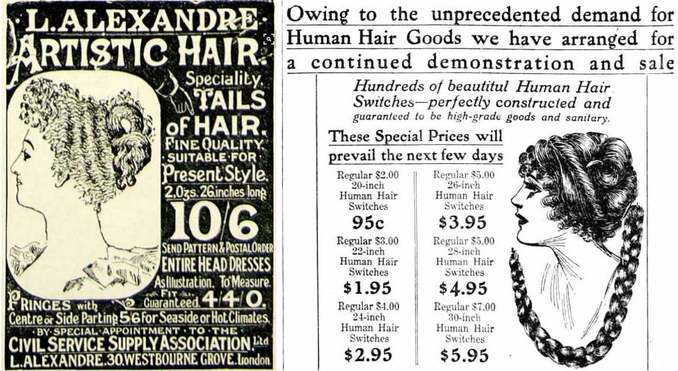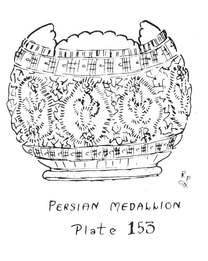The Curious Case of the Persian Medallion Hair Receiver
Originally published in July 2016
|
It was the braided hair, carefully fashioned into a bracelet (right) that caught our eyes. We had visited a National Trust stately home called Hinton Ampner, and spotted the bracelet inside a display case. The tag read “Plaited Hair Remembrance Bracelet”. Our curiosity was aroused; how was it made, was it a popular thing to do, and we wondered if there was a connection to Carnival Glass Hair Receivers. The Lost Art Of Hair Jewellery Prepare to be amazed … during the 1800s, there was something of a craze for creating “jewelry” (sic) out of hair. An astonishing book called the “Self-Instructor in the Art of Hair-Work” (by Mark Campbell, 1867) gave painstakingly detailed instructions how to create some stunningly magnificent items. The hair used for “jewelry” would have been purchased, and (according to Campbell’s book) was primarily sourced in Europe, with Paris being the number one spot for the “procurement of hair”! The longer the hair, the more expensive it was, and the most sought after hair of all was pure white hair. |
Above, left: the “braider” at work c.1867! It looks like a very tricky and complex task.
Centre: astonishingly, all these exquisitely detailed items were made from human hair.
Right: this seems to be the style of braiding used on the Hinton Ampner Remembrance bracelet.
Centre: astonishingly, all these exquisitely detailed items were made from human hair.
Right: this seems to be the style of braiding used on the Hinton Ampner Remembrance bracelet.
What about Hair Receivers?
Having discovered this huge international market in hair that continued into the early 1900s, we wondered if there was a connection with hair receivers.
|
We knew that in days gone by, ladies would save pieces of hair from their brushes and combs in a hair receiver. So, what was the hair gathered in a hair receiver used for? Was it used for “jewelry” too? Or for making elaborate wigs? The answer we discovered was a definite “no”. The broken bits of hair would usually have been stuffed inside a hairnet by the lady herself, and formed into what was known as a hair “ratt” (also called “rat”). She would then have inserted the “ratt” into her hair-do, to create a “big hair” effect. Pump up the volume with a Rat. There were other uses too, for that tangled mass of broken hair that amassed within a hair receiver. Pincushions and little pillows were stuffed with it, and we know for certain that an elderly friend of ours from long ago, used to hang parcels of human hair on plants in her vegetable garden to keep the deer away! |
Above, left: an advert from 1895 for “Artistic Hair”.
Right: advert for “Human Hair Switches” (guaranteed “sanitary”) from the 1916 Rock Island Argus (Illinois, USA). |
|
The Hair Receiver Itself Let’s get up close and personal with the hair receiver itself, to understand exactly what it was, and how popular an item it was, “back in the day”. The “Wallace Hostess Book” (1875) states that the “indispensibles” on “milady’s dressing table” were “brush and comb, hand mirror, button hook and shoe horn, together with a powder box and hair receiver”. The form that the conventional hair receiver took was usually round and lidded, and crucially it was characterised by a finger wide hole in the lid through which the hair would be pushed - on the right are typical examples of such hair receivers, as shown in a 1911 jewellery catalogue. |
Naturally, our thoughts moved on to the well known Carnival Glass Persian Medallion hair receiver. We started to investigate and that’s when everything began to turn upside down!
Persian Medallion Hair Receiver
Is the Persian Medallion hair receiver what we think it is? Was it actually intended to be a hair receiver? The answer seems to be … probably not. So what exactly was it intended to be? The answer seems to be … a rose bowl. Let’s take a look at the back-story behind the Persian Medallion hair receiver.
Fenton's Persian Medallion.
Left to right: blue rose bowl with a round top opening; marigold, square top, hair receiver; a rarely seen white, square top, hair receiver.
Pictures courtesy Seeck Auctions
Left to right: blue rose bowl with a round top opening; marigold, square top, hair receiver; a rarely seen white, square top, hair receiver.
Pictures courtesy Seeck Auctions
The item that Carnival Glass collectors refer to as the Persian Medallion hair receiver is characterised by having a square top opening – while the same item but with a round top opening is known as a rose bowl. The square top items (“hair receivers”) are mainly known in blue and marigold, with white examples being very scarce. The round top item (“rose bowls”) are known in a wider range: found in amethyst (only eight auction sales in 22 years), blue, green (three sales, probably all whimsies from the small plate), marigold, and white. Sincere thanks to Joan Doty for her information on colour availability, from Dave Doty’s auction price database.
|
Both top openings are shown on the right, on these two marigold Persian Medallion items. On the left is the round top (the “rose bowl” shape) and right, the square top (the “hair receiver” shape). Photo courtesy Seeck Auctions. Fenton introduced their Persian Medallion pattern in 1911, adding a rose bowl with a round top opening in 1912. Then, in 1916, an ad appeared in Butler Brothers showing a Persian Medallion with a square top opening ... but it was still described as a “rose bowl”. |
|
On the left: 1912 - an Orange Tree powder jar (described as a “covered puff box”) alongside a Persian Medallion rose bowl with a round top opening. it was clearly described in the ad as a 4½ inch rose bowl. On the right: 1916 - an Orange Tree mug alongside what collectors today call a Persian Medallion hair receiver with a square top opening. However, in this ad it was clearly described as a 4½ inch rose bowl. |
|
Further evidence showing that the square top Persian Medallion item was originally intended as a rose bowl comes from Fenton’s own early catalogues.
A 1915 illustration pictured the square top Persian Medallion item with the words, “598 Rose Bowl” (ref: “Fenton Art Glass 1907 – 1939” M&K Whitmyer – see page 31). William Heacock too, referred to the shape with the square top opening as a “rose bowl” in his 1978 “Fenton The First Twenty Five Years”. Furthermore, neither Presznick nor Hartung mentioned a “hair receiver” in the Persian Medallion pattern. In fact, Rose Presznick, in her Book 1, described this shape as a rose bowl too - her drawing is shown on the right, and the square top opening is clear. In the section on shapes for Persian Medallion in this book, she lists it under rose bowl thus: sm. – flat base sq. scallop top. So, when did the square top Persian Medallion rose bowl begin to be referred to as a hair receiver? In fact the first mention we can find of the square top being a hair receiver is in Sherman Hand’s 1968 soft-back "Colours in Carnival Glass Book 2". Curiously, although the text refers to two pictured items as rose bowl and hair receiver, both of the items illustrated have square top openings! Was this the first reference to the square top being a hair receiver? Can any reader add more information or evidence to help solve this mystery? |
Conclusion
Based on the accepted, typical shape of most hair receivers (lidded and with a small, round opening), the square top Persian Medallion item does not conform. In fact if you think about it, the bits of hair stuffed inside an open (square top) Persian Medallion piece would get messy rather quickly, as the wide opening would allow dust, powders and so on, onto the hair. And of course, early catalogue evidence from Butler Brothers and also from Fenton themselves shows the item was actually intended to be a rose bowl.
Based on the accepted, typical shape of most hair receivers (lidded and with a small, round opening), the square top Persian Medallion item does not conform. In fact if you think about it, the bits of hair stuffed inside an open (square top) Persian Medallion piece would get messy rather quickly, as the wide opening would allow dust, powders and so on, onto the hair. And of course, early catalogue evidence from Butler Brothers and also from Fenton themselves shows the item was actually intended to be a rose bowl.
|
Why two differently shaped top openings? It’s not possible to answer with certainty, but most likely it was just to add variety and increase sales opportunities. At some point, over time collectors began to call the square top shape a hair receiver. It had a benefit … collectors were able to differentiate between the round and square top shapes. Collector terminology is vital for good communication and recording. We’ll surely all continue to call the square top a hair receiver, as it has firmly entered Carnival vernacular now. The final question is, are there any true Carnival Glass hair receivers - ones that were actually intended to be hair receivers? The answer is that there were probably no hair receivers “in the line” – no mass production of Carnival shapes that were meant to be used to hold milady’s hair. However, there is a one-of-a-kind whimsy version, and it’s a beauty. Here it is on the left, courtesy of Dave Doty: a Millersburg Feather and Heart marigold tumbler that was whimsied into a hair receiver shape, with a small opening on top, just big enough to push hair into. |
With sincere thanks to Joan Doty for her information on colour availability, from Dave Doty’s auction price database.









